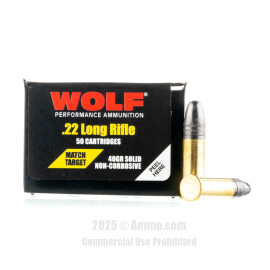
Wolf 22 LR Ammo For Sale
Overview of Wolf 22 LR Ammo
Key Features of Wolf 22 LR Ammo:
- Affordable Accuracy: Wolf .22 LR ammo offers an exceptional balance of cost-effectiveness and accuracy, making it an excellent choice for target practice, plinking, and varmint control.
- Match-Grade Options: Available in two high-quality varieties, Wolf .22 LR Match Target and Match Extra, both loaded with 40-grain lead round nose (LRN) bullets for precision shooting.
- Versatile Use Cases: Ideal for everything from teaching new shooters to pest control, offering consistent performance at a fraction of the cost of other match-grade ammunition.
Wolf .22 LR ammo provides shooters with a reliable and affordable option for honing their marksmanship skills or taking care of varmint issues. Its low recoil and minimal cost per round make it perfect for both beginners and seasoned shooters who enjoy long sessions at the range.
Use Cases for Wolf 22 LR Ammo:
- Target Practice and Plinking Options:
- Match Target: Offers excellent accuracy for general shooting or competitive practice without breaking the bank.
- Match Extra: Designed for more precision, this is a great option for shooters who demand a little extra from their ammunition.
Wolf .22 LR ammo offers an unbeatable combination of affordability and performance, making it an ideal choice for target shooting, plinking, and pest control.
Read our Wolf 22 LR Ammo Reviews
| Ammo Brand | Review |
|---|---|
| Aguila .22 LR | Read Review |
| Federal 22LR AutoMatch | Read Review |
Customer Reviews
-
Ken said:
Bought 1000 rounds from lot 3122-30189, fired approximately 350 and had 5 short rounds from cartridges from 2 different boxes. Trying to prepare for USBR rim fire competition and now not sure I can trust this ammo? Had to rod the barrel to insure I didn't have a squib round, this takes time and deflection from competition.
-
FC said:
This fires very well and is worth the extra money. If you use 22 cal for self defense buy this one. Never had a misfire with it. This is with the product made in Germany. I haven't tried if from England yet.
-
Schneider said:
Am very satified with the performance in our rifles: Hope you get some more in before long~~~





